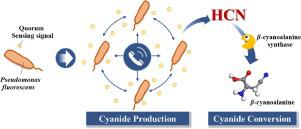Resources, Conservation and Recycling ( IF 11.2 ) Pub Date : 2022-09-22 , DOI: 10.1016/j.resconrec.2022.106670 Mi Lin , Zichun Yao , Pengcheng Wang , Yonggao Fu , Jujun Ruan

|
Replacing virgin mining with urban mining is an important step to achieve resources recycling and carbon emission reduction. Bio-cyanidation is an environmentally-friendly technology to recover precious metals from waste printed circuit boards, a type of typical urban minerals. However, the limited cyanide-producing ability and the risk of cyanide containing solutions restricts its industrial applications. Investigating the regulation mechanism of cyanide production and conversion helps solve the current dilemma. In this experiment, the concentration of cyanide produced by Pseudomonas fluorescens increased first and then decrease, involving two processes of cyanide production and conversion. The quorum sensing signal concentration was 1.34 µg/L, 1.96 µg/L, and 2.32 µg/L at 12 h, 18 h, and 24 h, respectively. Meanwhile, the transcriptome profiling revealed that the differentially expressed genes were enriched in the pathway of quorum sensing. Combined the two results, the quorum sensing was inferred as the drive of cyanide production. Unused cyanide was converted into β-cyanoalanine by β-cyanoalanine synthase, of which the concentration reached the lowest at the cyanide concentration peak. The findings help regulate the cyanide-production and conversion in bio-cyanidation process and contributes to the recovery of precious metals from waste printed circuit boards.
中文翻译:

废印刷电路板贵金属生物氰化常用荧光假单胞菌氰化物生成及转化调控机理
以城市矿山替代原始矿山,是实现资源循环利用和碳减排的重要举措。生物氰化是一种从废旧印刷电路板中回收贵金属的环保技术,是一种典型的城市矿产。然而,有限的氰化物生产能力和含氰溶液的风险限制了其工业应用。研究氰化物生产和转化的调控机制有助于解决当前的困境。在本实验中,荧光假单胞菌产生的氰化物浓度先增加后减少,涉及氰化物生产和转化两个过程。在 12 小时、18 小时和 24 小时,群体感应信号浓度分别为 1.34 µg/L、1.96 µg/L 和 2.32 µg/L。同时,转录组分析显示差异表达的基因在群体感应途径中富集。结合这两个结果,群体感应被推断为氰化物生产的驱动力。未使用的氰化物经β-氰丙氨酸合酶转化为β-氰丙氨酸,在氰化物浓度峰值处浓度最低。这些发现有助于调节生物氰化过程中氰化物的产生和转化,并有助于从废印刷电路板中回收贵金属。











































 京公网安备 11010802027423号
京公网安备 11010802027423号